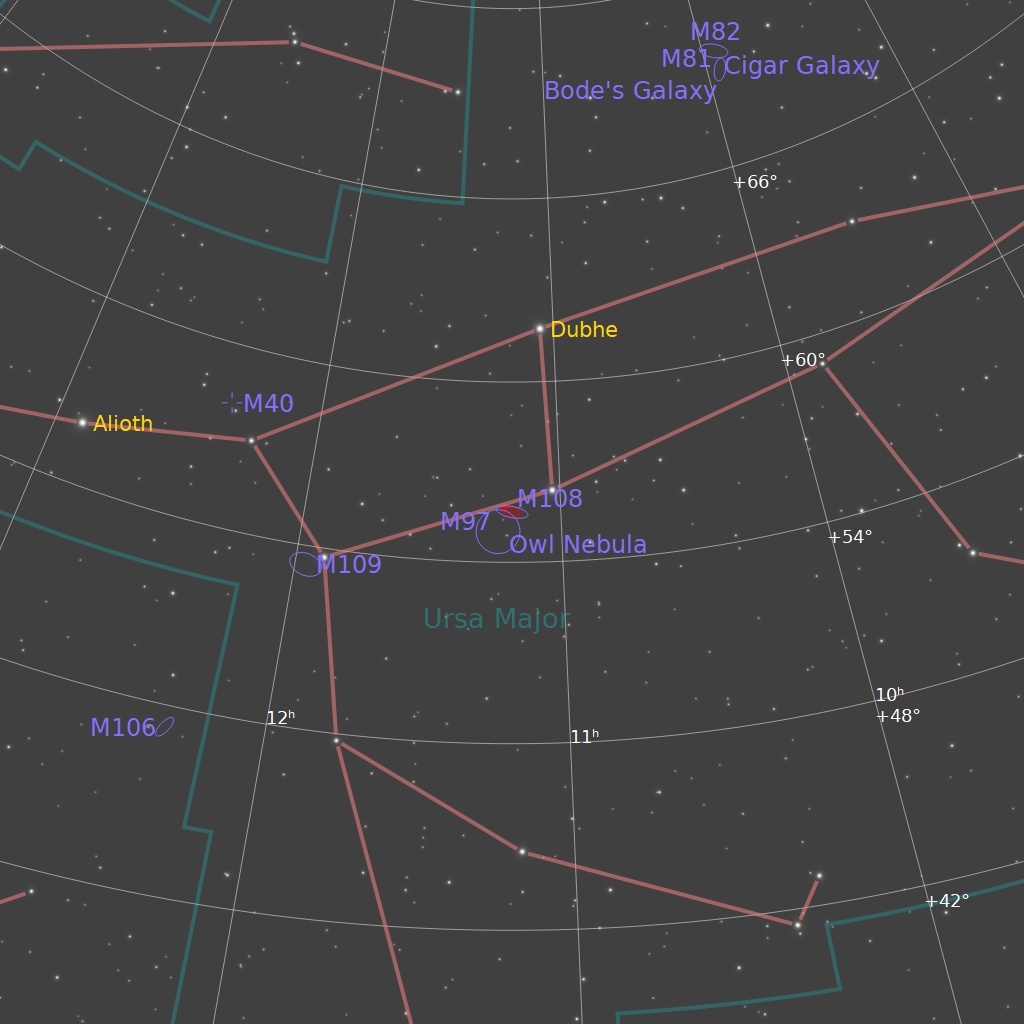M108, Barred Spiral Galaxy
 Click image for full size version
Click image for full size version
June 4, 2024
M108 is a barred spiral galaxy in Ursa Major, near Merak, the lower-right star of the Big Dipper’s bowl. It lies about 46 million light years away. M108 belongs to the Ursa Major galaxy cluster, which in turn is a member of the Virgo Supercluster of galaxies. This image includes many galaxies that lie much further away than M108. Look for streaks and smudges that look different from the sharper stars. You can also look at the annotated image, where many of them are labelled.
This very active galaxy displays the full range of colours found in some spiral galaxies, including pink nebula, blue star clusters, a yellow/orange core and many dark brown dust lanes throughout. The super-massive black hole at the centre of M108 has a mass about 24 million times the Sun’s.
M108 lies near (in the sky) to the Owl Nebula, although they’re actually very far apart. I’ve previously posted an image of them together in the same field.
Tekkies:
Acquisition, focusing, and control of Paramount MX mount with N.I.N.A., TheSkyX and PHD2. Primalucelab low-profile 2″ Essato focuser and ARCO rotator. Guiding with PHD2. Equipment control with PrimaLuce Labs Eagle 4 Pro computer. Flats taken using a Primalucelab Giotto 430 mm flat panel. All pre-processing and processing in PixInsight. Acquired from my SkyShed in Guelph. Data acquired under nearly moonless skies with average or better transparency and and average seeing between May 25 – 30, 2024.
Celestron 14″ EDGE HD telescope at f/11 (3,912 mm focal length) and QHY600M camera binned 2×2 with Optolong filters.
26 x 5m Red = 2hr 10m
24 x 5m Green = 2hr 00m
25 x 5m Blue = 2hr 05m
13 x 5m Ha = 1hr 05m
Total: 7hr 20m
Preprocessing: The WeightedBatchPreProcessing script was used to perform calibration, cosmetic correction, weighting, registration, local normalization and integration of all frames.
RGB master: A master RGB image was made from the Red, Green and Blue masters using ChannelCombination in RGB mode.
Gradient Removal: DBE was used to remove gradients from the RGB and Ha masters.
Colour Calibration: SpectroptometricColorCalibration was used to calibrate the RGB master.
Deconvolution: BlurXterminator was applied to the two masters with Automatic psf , star sharpening set to 0.4, and non-stellar set to 0.5.
Star Removal: StarXterminator was used to remove the stars from both masters, with default settings, except Large Overlap was selected. Only the RGB stars-only image was retained.
Linear Noise Reduction: NoiseXterminator was applied to the both masters with settings Amount=0.9 and Detail=0.25
Ha Continuum Subtraction: The ContinuumSubtraction script was used to remove continuum emissions from the Ha image.
Stretching: HistogramTransformation was applied to both masters to make pleasing images. Approximate background level after stretch was 0.08 for Ha and 0.10 for RGB.
Nonlinear Processing
Addition of Ha to RGB: The NBRGBCombination script was used to add Ha to the RGB
Nonlinear Noise Reduction: NoiseXterminator was used to reduce noise in the background areas of the image with Amount=0.9 and Detail=0.15.
Re-stretch: HistogramTransformation was used to boost contrast by moving the dark point to the toe of the histogram and slightly decreasing the mid-point slider.
Contrast Enhancement: LocalHistogramEqualization was applied twice. A Contrast Limit of 1.5 and 1 iteration was used for each LHE application (scale 40, strength 0.25; scale 90, strength 0.2).
Sharpening: MultiscaleMedianTransform was applied. (Layers 2 – 4 with strengths of 0.06, 0.06, and 0.03, respectively), using a mask to select only the galaxy.
Contrast, Brightness and Colour: Background and galaxy brightness, contrast, and saturation were adjusted in several iterations using CurvesTransformation with masks as required.
Stars-only steps: HistogramTransformation was applied to the RGB stars-only image. A mask was made by using ChannelExtraction to extract the luminance from the image. CurvesTransformation CIE c* slider was used to add boost colour in the stars through the star mask. A mask was made to select the largest star and CurvesTransformation was used to make it a little smaller.
Star Restoration: PixelMath expression combine(starless, stars, op_screen()) was used to combine the starless HaRGB starless image with the stars-only image.
Final Steps: Background, galaxy, and star brightness, contrast, hue, and saturation were adjusted in several iterations using CurvesTransformation with masks as required. ICCProfileTransformation (sRGB IEC61966-2.1; Relative Colorimetric with black point compensation) was applied prior to saving as a jpg. The finder chart was made using the FindingChart process. The annotated version was made using the AnnotateImage script.








Very cool!
I’m looking for a set up that will give full access to my telescope to someone else over the net. I don’t know what it is called, I just know that some people that have dark sky’s rent out their telescopes with this system. I don’t know what it is and was hoping you would know. I’m not trying to make extra cash I just have family members overseas and when I can go to a dark sky site they can be with me. Can you help? I know this isn’t what you do.
Hi there. If you can set up remote access with Team Viewer or AnyDesk, anyone can log in and see what you are doing on the computer, and even control your equipment.